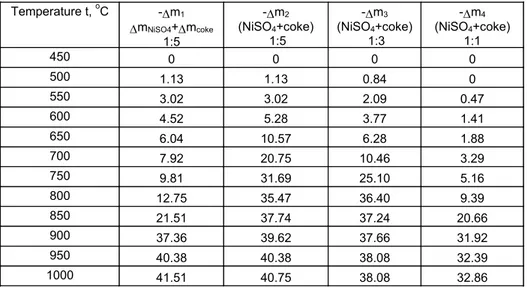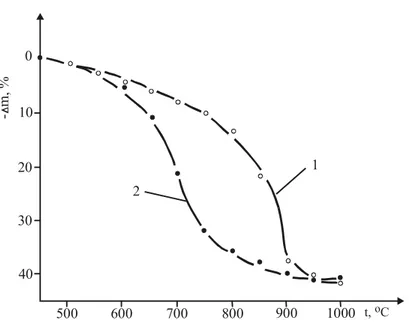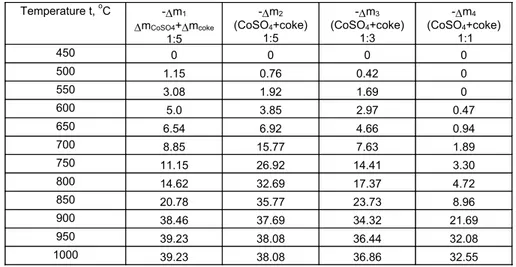DTA AND TGA STUDY OF MeSO
4(Me = Fe, Co, Ni) DISSOCIATION
IN THE PRESENCE OF COKE
B. S. Boyanov
University of Plovdiv, Faculty of Chemistry, 4000 Plovdiv, Bulgaria
(Received 11 January 2002; accepted 5 May 2002 )
Abstract
MeSO4(Me = Fe, Co, Ni) dissociation is investigated in order to estimate the effect of
temperature, time and presence of coke as reducer on the degree and mechanism of dissocia-tion. It is proved that the presence of coke decreases the dissociation temperature consider-ably and increases the degree of MeSO4dissociation.
Based on the obtained experimental data, a mechanism of the processes is proposed. The obtained results can be used in the industrial production of non-ferrous metals for explaining the processes that take place in the reduction of zinc and lead cakes in order to achieve favorable environmental, technical and economic results.
Keywords: DTA; TGA; sulfates; dissociation; coke
1. Introduction
of ferrites and other insoluble compounds, containing precious metals, FeSO4 can be used [2-5]. So it is necessary to investigate its dissociation under various conditions.
Nickel is an obstructive element in zinc electrodeposition but always accompanies it in natural raw materials [6]. Its presence in the form of a sulfate or oxide increases the quantity of the nickel passing into the solution.
Nickel and cobalt accompany in measurable quantities the copper raw materials much more often [7]. In some technological schemes it is possible to obtain their sulfates which dissociate in a subsequent thermal treatment. That is why it is interesting to examine their behaviour in the presence of the most frequently used solid fuel – coke.
Cobalt, like nickel, is also an obstructive element in zinc electrodeposition, as it always accompanies zinc in natural raw materials [6,8]. The two elements are found in the zinc calcine in the form of sulfates and oxides, which increases the quantity of the impurities passing into the solution.
The dissociation of CoSO4.7H2O and NiSO4.6H2O is important for the final phase, under which the two elements can be present in the zinc cake that goes to wealzing.
The dissociation of different metal sulfates [9-14] has been studied mainly in an oxidizing or inert atmosphere. There are too little data, however, for their behaviour in a reducing environment, which is important from both theoretical and practical point of view.
Therefore, the present study using DTA and TGA is aimed to examine the behaviour of MeSO4 (Me = Fe, Co, Ni) in the presence of coke in various ratios to the sulfates. The data obtained and those published earlier should be interpreted in terms of raw materials containing different sulfates.
2. Experimental
The sulfates studied have a purity of p.a. The coke characteristics and derivatogram are displayed in [15]. Fraction of 0.12 mm was used. The mass ratio MeSO4: C in the mixtures studied is 1:1, 1:3, and 1:5.
heating rate, 10o min-1; sample mass 200-300 mg sulfate, coke or their
mixture. All the studies were performed in the air medium. A ceramic crucible was used.
Calculations, based on the chemical composition, are made for different ratios of MeSO4 : C in the tested samples. The degree of dissociation of MeSO4 is calculated on the basis of the obtained TG curves.
X-ray diffraction analysis was carried out with a TUR-M62 apparatus (Dresden, Germany) using CoKaradiation and an iron target.
3. Results and discussion
3.1 Dissociation of FeSO4 .7H2O + coke
The derivatogram of pure FeSO4.7H
2O is shown in Fig.1 and the
derivatogram of the mixture of FeSO4.7H
2O and coke – in Fig.2.
200
20 40 60
0 400 600 800 1000 t, Co 90
100
305 600
730 TG
DTG DTA
275 105
300
720
300
715
dm dt
t
-
m
,
%
From these two derivatograms, it is obvious that up to a temperature of about 310 oC dehydration takes place following the same mechanism. After
the completion of a process, the mass of the samples, under the temperature of the solid fuel combustion, remains constant. From the derivatogram of the mixture, it is obvious that after that temperature, decreasing of the sample mass is observed, which is connected with two different rates of the process. But in the pure FeSO4 dissociation takes place with a maximum of the endothermal effect at 720oC.
Table 1 presents the data for the mass change of the samples during their thermal treatment.The symbols used in the table are: ∆m1 - loss of mass of pure FeSO4.7H
2O + loss of mass of coke (FeSO4: C = 1:5); ∆m2- loss of mass
of the mixture of FeSO4.7H
2O and coke (1:5); ∆m3 - loss of mass of the
mixture of FeSO4.7H2O and coke (1:3); ∆m4- loss of mass of the mixture of
200
20 40 60
0 400 600 800 1000 t, Co 100
105
310 500
630
TG DTG DTA
105 310
500 625
925
300
610 500
dm dt
t
-
m
,
%
FeSO4.7H2O and coke (1:1).
Fig. 3 shows the curves of the sum of the mass change for the individual FeSO4.7H2O and coke (curve 1), and their mixture (curve 2).
It is evident that the loss of about 25-30 % of the mixture mass of FeSO4 and coke is reached at a temperature about 70-80 oC lower than the one of
individual FeSO4 heating. That is why in this case the acceleration of the dis-sociation process in the presence of solid fuel is less compared to that of CuSO4.5H
2O or ZnSO4.7H2O [16]. This is mainly due to the lower
dissocia-tion temperature of FeSO4.
3.2 Dissociation of NiSO4.6H2O + coke
Fig. 4 presents the derivatogram of pure NiSO4 . 6H
2O, while in Fig. 55
derivatogram of NiSO4. 6H
2O and coke (NiSO4: coke=1:5) are given.
It is evident that the dissociation process takes place in different ways for the two samples. Before the temperature of coke combustion, dissociation takes place, following one and the same mechanism. The dehydration of NiSO4.6H
2O is a three-stage process. Calculations show that at a temperature
Temperature t, o
C
-∆m1
∆mFeSO4+∆mcoke 1:5
-∆m2 (FeSO4+coke)
1:5
-∆m3 (FeSO4+coke)
1:3
-∆m4 (FeSO4+coke)
1:1
450 0 0 0 0
500 1.15 1.53 1.27 0.47
550 2.67 5.73 4.64 1.42
600 4.58 24.05 16.46 6.60
650 9.16 39.31 43.04 17.92
700 23.28 40.84 44.30 35.38
750 40.08 43.51 45.99 44.81
800 42.37 45.42 47.26 45.28
850 44.27 47.33 48.10 45.75
900 46.18 49.24 48.52 46.23
950 47.70 50.0 48.95 47.17
1000 48.09 50.76 48.95 47.17
t, oC 1 2 0 10 30 20 40 50
500 600 700 800 900 1000
- m , % 200 20 40 60
0 400 600 800 1000t, Co
110 145 115 170 390 905 TG DTG DTA 120 160 375 890 360 880 dm dt t - m , % 200 20 40 60
0 400 600 800 1000 t, Co
120 180 800 TG 120 145 DTG 370 720 DTA 125 160 380 930 dm dt t - m , %
Fig.3. Mass change of FeSO4.7H2O and coke:individually treated (1) and
their mixture (2)
Fig.4. Derivatogram of NiSO4.6H2O Fig.5. Derivatogram of NiSO4.6H2O
of about 115°C two molecules of water are dismissed, and further another three molecules at about 170oC – 180oC. The last sixth water molecule is
discharged at a temperature of 390°C. After that temperature the mixture of NiSO4 and coke sharply decreases its sample mass. At the same time in the pure NiSO4 dissociation takes place with a maximum of the endothermal effect at 890°C, while the thermal effect of this process in the mixture of NiSO4 and coke is not clearly expressed. The end temperature of the dissoci-ation of pure NiSO4 is 925°C, and in the presence of coke it decreases.
The data for mass change during the thermal treatment of the samples are presented in table 2. The symbols used in the table are: ∆m1 - loss of mass of pure NiSO4.6H2O + loss of mass of coke (NiSO4: C = 1:5); ∆m2- loss of mass of the mixture of NiSO4.6H2O and coke (1:5); ∆m3- loss of mass of the mixture of NiSO4.6H2O and coke (1:3);∆m4- loss of mass of the mixture
of NiSO4.6H2O and coke (1:1).
The curves of the sum of the mass change for the individual samples of NiSO4.6H2O and coke (curve 1) and their mixture (curve 2) are presented in Fig.6.
Temperature t, oC -∆m1
∆mNiSO4+∆mcoke 1:5
-∆m2 (NiSO4+coke)
1:5
-∆m3 (NiSO4+coke)
1:3
-∆m4 (NiSO4+coke)
1:1
450 0 0 0 0
500 1.13 1.13 0.84 0
550 3.02 3.02 2.09 0.47
600 4.52 5.28 3.77 1.41
650 6.04 10.57 6.28 1.88
700 7.92 20.75 10.46 3.29
750 9.81 31.69 25.10 5.16
800 12.75 35.47 36.40 9.39
850 21.51 37.74 37.24 20.66
900 37.36 39.62 37.66 31.92
950 40.38 40.38 38.08 32.39
1000 41.51 40.75 38.08 32.86
The figure shows that the acceleration of the dissociation process with the presence of solid fuel in the sample is significant. Loss of mixture mass of about 20 % in NiSO4.6H2O and coke is reached at a temperature 150oC lower
than the one of individual thermal treatment of NiSO4.6H2O.
3.3 Dissociation of CoSO4.7H2O + coke
Fig 7 displays the derivatogram of pure CoSO4.7H2O, while that of the mixture of CoSO4.7H2O and coke is shown in Fig.8. The two derivatograms reveal the following:
1. The process of dehydration in both cases takes place in a two-stage mechanism. In the first stage at 110-130oC the six molecules of water are
dismissed and at a temperature of 340-350oC (second stage of the process) the
last seventh molecule is discharged. 2. In the mixture of CoSO4.7H
2O and coke, a sharp decrease of the sample
mass is noticed, which occurs at a temperature about 180oC lower than the
temperature of dissociation of the anhydrous CoSO4. The process takes place
t, oC 1
2 0
10
30 20
40
500 600 700 800 900 1000
-
m
,
%
Fig. 6. Mass change of NiSO4.6H2O and coke: individually treated (1) and
very intensively, which can be seen from the endothermal effect at 705 °C on the DTA curve and at 710 °C on the DTG curve. The data in Table 3 and Fig.9 are also indicative of the intensity of the dissociation process.
From the derivatograms of 3CdSO4.8H2O and its mixture with coke it is noticeable that in the two samples up to about 450 °C the process follows the same mechanism. Twostage dehydration takes place at temperatures of 90 -100 °C and 200 - 215 °C respectively. After dehidration the sample mass remains the same up to about 450 °C.
The anhidrous CdSO4 remains stable in a very wide temperature interval (250 - 950 °C) and at 800 - 840 °C phase transitions according to the following scheme are observed:
800 °C 840 °C
α-CdSO4 → β-CdSO4 → γ−CdSO4
200
20
40
60
0 400 600 800 1000 t, Co
110 130 340 900 TG DTG DTA 340 900 330 110 900 dm dt t - m , % 200 20 40 60
0 400 600 800 1000 t, Co
110 110 350 TG DTG DTA 350 830 705 600 350 110 710 dm dt t - m , %
Fig.7. Derivatogram of CoSO4.7H2O Fig.8. Derivatogram of CoSO4.7H2O
The CdSO4dissociation process begins only after 950 °C. It is evident from the derivatogram of the mixture of CdSO4and solid fuel that the dissociation starts after about 450 - 500 °C and takes place at a significant rate. The thermal effects that follow the reaction are not clearly stated.
The curves of change in the sample masses of individual CdSO4and coke (curve 1) and their mixture (curve 2) are presented in Fig. 10.
It is evident that the degree of dissociation in the presence of solid fuel is higher by about 10% compared to the degree of dissociation of pure CdSO4.
Because of the higher temperature of CdSO4decomposition compared to that of the other studied sulfates, up to about 700 °C curves 1 and 2 are almost identical. Above this temperature the effect of the burning fuel on the dissoci-ation is significant and the loss of mass on curve 2 is considerably greater. At 1000 °C, CdSO4dissociation is not complete which is why curves 1 and 2 at this temperature do not coincide. This fact shows that in a reducing process with the presence of CdSO4, its dissociation is greatly intensified when solid fuel is present, and the reducing of CdO will be greatly intensified.
The obtained results for the dissociation of the studied MeSO4(Me=Zn, Cu, Pb, Cd, Fe, Co, Ni) [15,16] in the presence of solid fuel are the grounds for making the following general conclusions:
Temperature t, oC -∆m1
∆mCoSO4+∆mcoke
1:5
-∆m2
(CoSO4+coke)
1:5
-∆m3
(CoSO4+coke)
1:3
-∆m4
(CoSO4+coke)
1:1
450 0 0 0 0
500 1.15 0.76 0.42 0
550 3.08 1.92 1.69 0
600 5.0 3.85 2.97 0.47
650 6.54 6.92 4.66 0.94
700 8.85 15.77 7.63 1.89
750 11.15 26.92 14.41 3.30
800 14.62 32.69 17.37 4.72
850 20.78 35.77 23.73 8.96
900 38.46 37.69 34.32 21.69
950 39.23 38.08 36.44 32.08
1000 39.23 38.08 36.86 32.55
t, oC 1
2 0
10
30 20
40
500 600 700 800 900 1000
- m
, %
Fig.9. Mass change of CoSO4.7H2O and coke: individually treated (1) and
their mixture (2)
t, oC 1
2 0
20 10
30
500 600 700 800 900 1000
-
m
,
%
Fig.9. Mass change of 3CdSO4.8H2O and coke: individually treated (1) and
1. The dehydration of MeSO4 that usually takes place up to a temperature of about 300 - 350 °C is not influenced by the presence of solid fuel, because of the low value of the temperature (before coke combustion). The mechanism of the dehydration process in both cases remains the same.
2. Above 450 °C, when coke combustion starts [15], the character of the dis-sociation process of the already obtained anhydrous sulfates changes signifi-cantly. It can be noticed in all sulfates that the dissociation process withdraws to lower temperatures, becomes more intense and that the type of curves, obtained by DTA and TGA, changes.
3. The character of the solid fuel effect on the dissociation of MeSO4 is approximately the same for all of them, except CdSO4. Because of the higher temperature of dissociation of CdSO4, the dissociation process at 1000 °C is not complete.
4. According to the decrease in the dissociation temperature, the solid coke has the most significant effect on CuSO4, followed by ZnSO4, NiSO4, CoSO4 and the slightest effect on FeSO4.
In CdSO4 above 850 °C, the dissociation in the presence of solid fuel is
greater by about 10% in comparison with the anhydrous CdSO4, and this value is maintained up to 1000 °C.
5. The probable mechanism of the processes taking place in the mixtures of MeSO4and solid fuel can be shown in the following reactions:
MeSO4→MeO + SO3 (1)
C + O2→CO2 (2)
CO2+ C ↔2CO (3)
t >700 °C
SO3 ↔ SO2+ 1/2O2 (4)
MeSO4+ CO → MeO + CO2+ SO2 (5)
MeSO4+ 4CO →MeS + 4CO2 (6)
MeS + 2O2→MeSO4 (7)
MeS + 3/2O2→MeO + SO2 (8)
temperature. This leads to formation of metal oxides products, which can be reduced to the corresponding metals comparatively more easily than other compounds. At the same time, formation of metal oxides (especially when PbO and SiO2 are present), can lead to obtaining low-temperature melting eutectics, partial melting of the material, worsening of its reduction, forming of crust on the fireproof brickwork.
4. Conclusions
1. It was established that in the system MeSO4– solid fuel the temperature of dissociation of all studied sulfates decreases (by about 100-200 oC). Based
on the effect of coke on the dissociation process (rate of dissociation – u), the studied sulfates can be arranged in the following order: uCuSO4>uZnSO4>uNiSO4
>uCoSO4>uFeSO4. The dissociation of CdSO4 is not complete up to 1000 oC.
2. On the basis of the obtained experimental data, a probable mechanism of the processes that take place is proposed.
3. The use of fuel decreases the sulfate content in the lead and zinc cake. This is of great importance to the choice of optimal conditions for carrying out the agglomeration and wealz processes. In the agglomeration of lead raw materials the adding of a small quantity of solid fuel would lead to an increase in the portion of the processed sulfate-containing semi-finished products.
References
1. R.Dimitrov and B.Boyanov,Rudarsko-Metalurski Zbornik, 31 (1984) 67.
2. A.P.Snurnikov and V.F.Larin, Non-ferrous Metals, 6 (1969) 29 (in Russian)
3. A.P.Snurnikov and V.F.Larin, Non-ferrous Metals, 7 (1969) 34 (in Russian)
4. B.S.Boyanov, Thermochimica Acta, 302 (1997) 109-115.
5. B.Boyanov, R.Dimitrov and N.Dobrev, Non-ferrous Metals, 5 (1986)
6. V.Karoleva, Metallurgy of Non-ferrous Metals, Tekhnika, Sofia, v.2, 1986, p.299 (in Bulgarian)
7. R.I.Dimitrov, B.S.Boyanov, Ya.P.Balabanov and G.N.Korudanov,
Non-ferrous Metals, 5 (1983) 12 (in Russian)
8. L. Muresan, G. Maurin, L. Oniciu and D. Gaga, Hydrometallurgy,43 (1996) 345.
9. M.E.Brown, D.Dollimore and A.K.Galwey, Solid State Reactions, Mir,
Moscow,1983, p.357 (in Russian)
10. Y.Pelovski, V.Petkova, I.Dombalov, and I.Grancharov,
J.Therm.Anal., 36 (1990) 1727.
11. H.Tagawa, Thermochimica Acta, 80 (1984) 23.
12. H.Tagawa and H.Saijo, Thermochimica Acta, 91 (1985) 67. 13. H.Tagawa and K.Kawabe, Thermochimica Acta, 158 (1990) 293. 14. H.Tanaka, M.Kawano and N.Koga, Thermochimica Acta, 182 (1991)
281.
15. B.Boyanov and R,Dimitrov, Thermochimica Acta, 322 (1998) 69. 16. B.Boyanov, Dissociation of MeSO4(Me = Zn, Cu, Pb) in the





